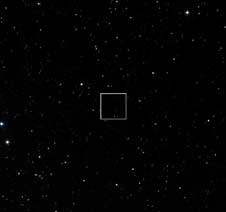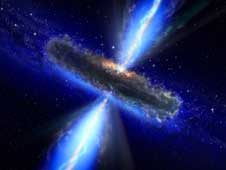Latest News
Swift Features
-

Gamma-Ray Burst Offers First Peek at a Young Galaxy's Star Factory
Astronomers have, for the first time, identified gas molecules in the host galaxy of a gamma-ray burst.
-

NASA's Swift Shows Active Galaxies Are Different Near and Far
An ongoing X-ray survey undertaken by NASA's Swift spacecraft is revealing differences between nearby active galaxies and those located about halfway across the universe.
-

Swift Looks to Comets for a Cool View
Swift caught sight of a splintered comet fragment as it passed by the Ring Nebula.
-

A Star That Bursts, Blinks and Disappears
Astronomers are reporting on a strange case where one of the littlest of stars "twinkled" with gamma rays, X-rays, and light -- and then vanished.
Mission News
-
NASA Satellite Detects Record Gamma Ray Burst Explosion Halfway Across Universe
03.20.08 - - A powerful stellar explosion detected March 19 by NASA's Swift satellite has shattered the record for the most distant object that could be seen with the naked eye.
-
NASA Scientists Catch a Unique Gamma-Ray Burst
05.11.05 - NASA scientists have, for the first time, detected and pinned down the location of a short gamma-ray burst, lasting only 50 milliseconds.
-
Cosmic Explosion Among the Brightest in Recorded History
02.18.05 - Scientists have detected a flash of light brighter than anything ever detected from beyond our Solar System.
-
Swift Images the Birth of a Black Hole
01.21.05 - The NASA-led Swift mission has detected and imaged its first gamma-ray burst.
Related Sites
-
Swift Mission →
08.21.04 - Learn more about the Swift mission.
Related Multimedia
-

Mission Accomplished!
NASA Launch Manager Chuck Dovale describes the successful launch and decisions for the short delay.
› View This Video -

Spacecraft Separation is Achieved!
Congratulations are offered all around as Swift begins its journey to nimbly seek out fleeting gamma-ray bursts on the fly.
› View This Video -

Swift Launches Successfully
A superb launch and flawless liftoff for NASA's Swift spacecraft to study the mystery of gamma-ray bursts.
› View This Video -

Swift Spacecraft Processing
John Honig, Swift launch site integration manager, describes spacecraft transporation and preparation process.
› View This Video

